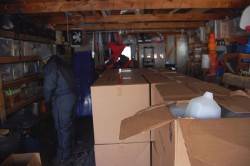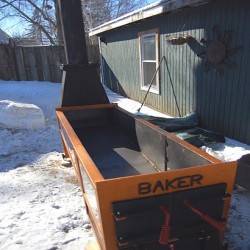Wearing a blue snowsuit and a knit cap, Sam Vandegrift’s boyish looks is only matched by his childlike enthusiasm. With temperatures bottoming out in the single digits, Sam points out the different maple trees he hopes to tap as part of his latest project, Prairie Sugar Collective. He notes the bark and the branches in between fits of giggles as he marvels at all the possible sources for community based maple syrup.
“The real hope is we end up having enough syrup to have a pancake breakfast,” Sam says about the first year of his project.
Sam, who works as a wine wholesaler for the Artisan Beverage Company, will gladly talk all day about food or wine or the community of Urbana.
“We have a pretty interesting neighborhood. We’re lucky that we have a bunch of people who dream big,” Sam says.
To really understand why Sam is standing  next to a frozen river in the woods outside Mahomet on a beautiful but bitterly cold Thursday in February, you need to go back three years. Three years ago Sam tapped two large sugar maples that grow in his front yard and collected enough sap for about a quarter of a cup of syrup. The next year he expanded to about 25 taps on his street.
next to a frozen river in the woods outside Mahomet on a beautiful but bitterly cold Thursday in February, you need to go back three years. Three years ago Sam tapped two large sugar maples that grow in his front yard and collected enough sap for about a quarter of a cup of syrup. The next year he expanded to about 25 taps on his street.
The idea was to make syrup, but also to educate people about the food sources that are literally in their front yard. Sam says he would have continued expanding until every maple tree in Urbana was producing sap if the city had not gotten involved. Some of the trees he used were on public property and could not be used. Also, taps could hurt already stressed urban trees that have to deal with pollution, root crowding and other unhealthy aspects of city living.
Most would stop there, but instead Sam started collecting out in the country. With some help from Lisa Haynes, owner of the organic farm Tomahnous Farm, Sam found property owners in Champaign county willing to let members of the Prairie Sugar Collective tap their trees.
 Sam says his main objective is still educational. He wants to put wheels on the evaporator built by Dave Baker, Sam’s neighbor and owner of Baker’s Bikes. The wheels will allow the collective to move syrup production to schools and businesses for instructional displays.
Sam says his main objective is still educational. He wants to put wheels on the evaporator built by Dave Baker, Sam’s neighbor and owner of Baker’s Bikes. The wheels will allow the collective to move syrup production to schools and businesses for instructional displays.
“The more we become removed from doing things that keep us alive I think the more alienated we feel from our own life,” Sam says.
Most people don’t know where the stuff in the maple leaf shaped bottle originally comes from. The sap from the maple tree has to be boiled down in an evaporator before it’s the right consistency. Sam says about 40 gallons of sap is needed to make a gallon of syrup. Enough sap needs to be collected over the short season, about 4 to 8 weeks in February and March, to last the entire year. High producing farms need huge areas of land filled with trees to keep up with demand.
Maple syrup is seen as more of a condiment than a food stuff. Sam says he wants to treat it more like wine, make single origin syrups or unfiltered batches. He says the people in the area are adventurous in their food and would probably enjoy that as much as he would.
“I just have the feeling that this is the beginning of something going bonkers and I’m not just chopping it up to my optimism,” Sam says.








